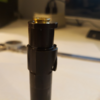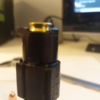eyeshot
Member
I have read the "Plunk Test" thread in the "Library of Wisdom" multiple times. I decided to try the pencil version of setting an OAL for my plunk test. Seems simple enough.
My bolt face to barrel end measurement is 3.366. I then dropped a Berry's down the pipe and held it in place with a factory cartridge. The bullet to end of barrel was 2.145. Subtracting out it comes to 1.221. That would be to the rifling if it actually gets there. Backing it off .015, as suggested, gives me 1.206. So, in theory, not taking into consideration feeding and extraction a 1.206 should fit my pistol. Or . . is this not as simple as I thought?
All my factory RN cartridges sit up pretty high, .081 on the south-end of my barrel. Maybe that's because it is a Beretta rotating barrel. Heck, I don't know. That's why I chose the pencil method.


Poor, massive photos I know. I'm just going to reload to the factory OAL until I get a handle on this. Feed it to me with a small spoon.
My bolt face to barrel end measurement is 3.366. I then dropped a Berry's down the pipe and held it in place with a factory cartridge. The bullet to end of barrel was 2.145. Subtracting out it comes to 1.221. That would be to the rifling if it actually gets there. Backing it off .015, as suggested, gives me 1.206. So, in theory, not taking into consideration feeding and extraction a 1.206 should fit my pistol. Or . . is this not as simple as I thought?
All my factory RN cartridges sit up pretty high, .081 on the south-end of my barrel. Maybe that's because it is a Beretta rotating barrel. Heck, I don't know. That's why I chose the pencil method.


Poor, massive photos I know. I'm just going to reload to the factory OAL until I get a handle on this. Feed it to me with a small spoon.







